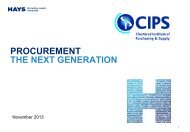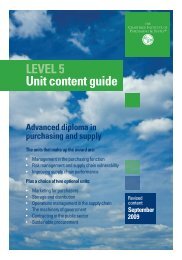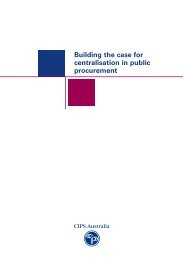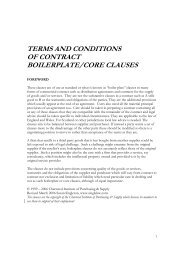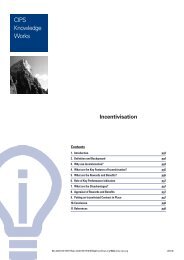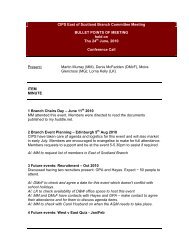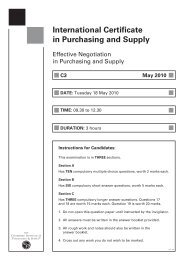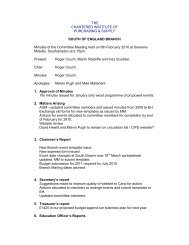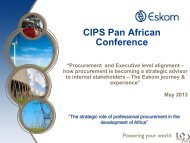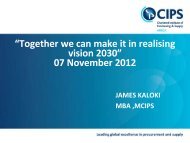Graduate diploma - The Chartered Institute of Purchasing and Supply
Graduate diploma - The Chartered Institute of Purchasing and Supply
Graduate diploma - The Chartered Institute of Purchasing and Supply
Create successful ePaper yourself
Turn your PDF publications into a flip-book with our unique Google optimized e-Paper software.
3.4 Determine <strong>and</strong> justify<br />
ways <strong>of</strong> developing<br />
organisational<br />
competencies so that<br />
purchasing can increase<br />
its productivity <strong>and</strong><br />
effectiveness<br />
• Why it is important to<br />
develop people in the<br />
workplace<br />
• Role <strong>of</strong> organisational<br />
competencies <strong>and</strong> the<br />
need to align purchasing<br />
competencies with<br />
functional <strong>and</strong> corporate<br />
strategies<br />
• <strong>The</strong> range <strong>of</strong> skills <strong>and</strong><br />
competencies for<br />
purchasing <strong>and</strong> supply that<br />
can be reliably assessed<br />
<strong>and</strong> measured<br />
• <strong>The</strong> purpose <strong>of</strong> training<br />
needs analysis (TNA) <strong>and</strong><br />
skills assessment<br />
• <strong>The</strong> processes <strong>of</strong> TNA <strong>and</strong><br />
the merits <strong>of</strong> independent<br />
assessment<br />
• Contrast between training<br />
<strong>and</strong> development<br />
• A range <strong>of</strong> training <strong>and</strong><br />
development solutions for<br />
purchasing, including the<br />
merits <strong>of</strong> blended learning<br />
<strong>and</strong> action-learning.<br />
4.0 LEADING CHANGE IN THE<br />
SUPPLY CHAIN<br />
(Weighting 35%)<br />
4.1 Propose how to develop<br />
compelling <strong>and</strong> innovative<br />
vision, values <strong>and</strong> culture<br />
for a purchasing function<br />
• <strong>The</strong> meaning <strong>of</strong> the term<br />
‘vision’ <strong>and</strong> its need to be<br />
compelling<br />
• How vision can be created<br />
<strong>and</strong> the actions required to<br />
gain buy-in<br />
• How vision should be<br />
communicated <strong>and</strong><br />
reinforced<br />
• <strong>The</strong> meaning <strong>of</strong> the term<br />
‘culture’ in the context <strong>of</strong><br />
the purchasing function<br />
• Role <strong>of</strong> the leader in<br />
promoting cultural change<br />
• An appropriate range <strong>of</strong><br />
values <strong>and</strong> organisational<br />
behaviours for the<br />
purchasing function <strong>and</strong><br />
the benefits <strong>of</strong> having<br />
explicit value statements<br />
• <strong>The</strong> importance <strong>of</strong><br />
corporate social<br />
responsibility (CSR) <strong>and</strong><br />
ethics in building<br />
sustainable values within<br />
the purchasing function.<br />
14<br />
4.2 Critically evaluate<br />
different models <strong>of</strong> change<br />
management in the<br />
purchasing function <strong>and</strong><br />
the wider organisation as<br />
a whole<br />
• Factors driving change <strong>and</strong><br />
their impact<br />
• <strong>The</strong> relative merits <strong>of</strong><br />
evolutionary versus<br />
revolutionary change<br />
(Balogun & Hope Hailey)<br />
<strong>and</strong> the respective<br />
implementation strategies<br />
these require in the<br />
purchasing context<br />
• Lewin’s models for<br />
planned change <strong>and</strong><br />
behavioural modification<br />
• <strong>The</strong> merits <strong>of</strong> employing<br />
external resources to lead<br />
organisational change.





